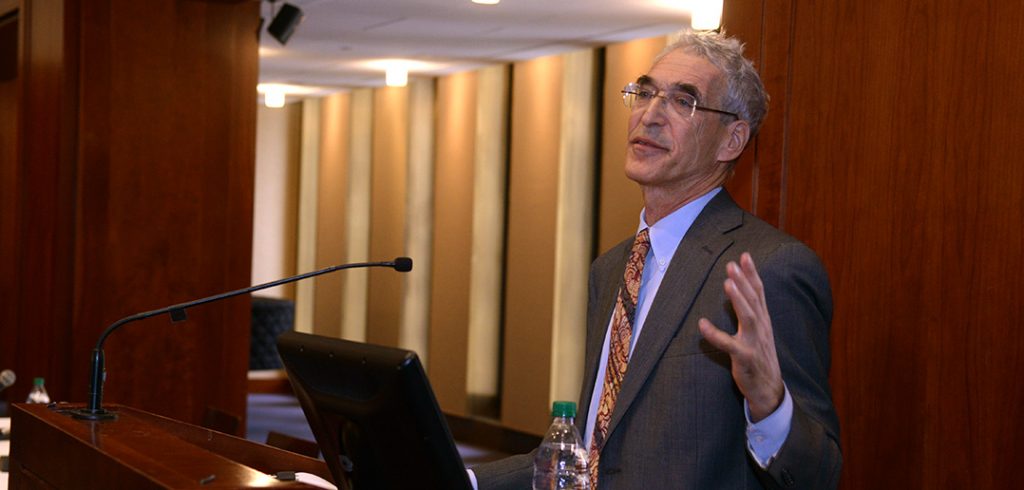Few years in recent history have been as turbulent in the United States as 1968, and New York City was no exception.
At a Feb. 6 lecture celebrating the 50th anniversary of Fordham College at Lincoln Center, Joshua B. Freeman, Ph.D., helped put the college into the larger context of the time.
In “New York City 1968. City in Turmoil; What Changed and What Didn’t,” Freeman, a distinguished professor of history at Queens College, made it clear that the changes that the city underwent at the time were both jarring and overdue.
“All around the world, it was one of those rare moments when the inconceivable became routine, when the strange became familiar, and when the familiar became strange,” said Freeman, who detailed the city’s transformation in American Empire, 1945-2000: The Rise of a Global Power, the Democratic Revolution at Home (Viking, 2012).
A Stinky Start to the New Year
To begin with, on Feb. 2, the city’s sanitation workers staged a nine-day long strike that resulted in 100,000 tons of uncollected garbage lying on the streets. In May, a dispute in Brooklyn over the firing of teachers metastasized into a series of city wide teacher strikes in the fall that lasted through mid-November. The city was split on fault lines of race, religion, class, and political beliefs.
“There seemed to be a total breakdown of governance. No one, not the Board of Education, not the mayor, not the governor, not the state legislature, seemed to be able to capable of restoring order,” he said.
Some of the change was inevitable. In 1947, there were 500,000 manufacturing jobs south of 60th Street in Manhattan, but manufacturing firms soon began departing for states less friendly to unions, the port moved to New Jersey and shifted to containers, and automation eliminated once plentiful jobs such as elevator operators and dish washers.
A New Vision of the City
Not everyone lamented the change. Freeman noted that developer William Zeckdorf proclaimed in 1956 that the decline in manufacturing was “a magnificent thing.” And Fordham’s Lincoln Center campus was central to a new vision of the city, thanks to master builder Robert Moses. The Lincoln Square Project, of which the campus was to be a part, was part of one of the largest redevelopment projects in the United States.
“It seems so odd now, but the arguments for this redevelopment project were really couched in the language of the Cold War. We had to show the world that were not just a great economic power, and military power, but we were a cultural leader as well,” Freeman said.
The project was so important, in fact, that President Dwight Eisenhower attended the groundbreaking for the complex in 1959.
Nine years later, young people around the globe were revolting against social, political and cultural structures that they considered bureaucratic, authoritarian and boring.
“Fordham was not exempt from these times. When the liberal arts college opened at the Lincoln Square campus, it was seen as something of a departure from undergraduate education at Rose Hill,” Freeman said.
“It was designed to be more secular, more interdisciplinary, and to give students much more freedom to manage their own education.”
The experiment was short-lived, and inspired protests from students when it was discontinued. But unlike their counterparts at Columbia University, Freeman noted that the Fordham administration did not respond to these and concurrent demonstrations at Rose Hill by calling the authorities.
“Still, the rapid demise of the college of liberal arts, at least in its original form, suggests how ephemeral much of the spirit of 1968 turned out to be,” he said.
A Lasting Impact
The impact of the redevelopment, on the other hand, is undeniable, as average apartment prices are higher today on the upper west side of Manhattan that the upper east side, something that would be inconceivable 50 years ago.
“To me, it is utterly astounding that across the street from here are the Amsterdam Houses, which were built in 1940 as the very first step in the redevelopment of this area. They remain public housing for people of modest means, on one of the most valuable pieces of real estate on the continent,” he said.
“Now, the west side of Lincoln Center is a forbidding wall with no way to get to it, and this campus can be a little tricky to get into as well. But the fact is, that the Amsterdam houses are there.”


